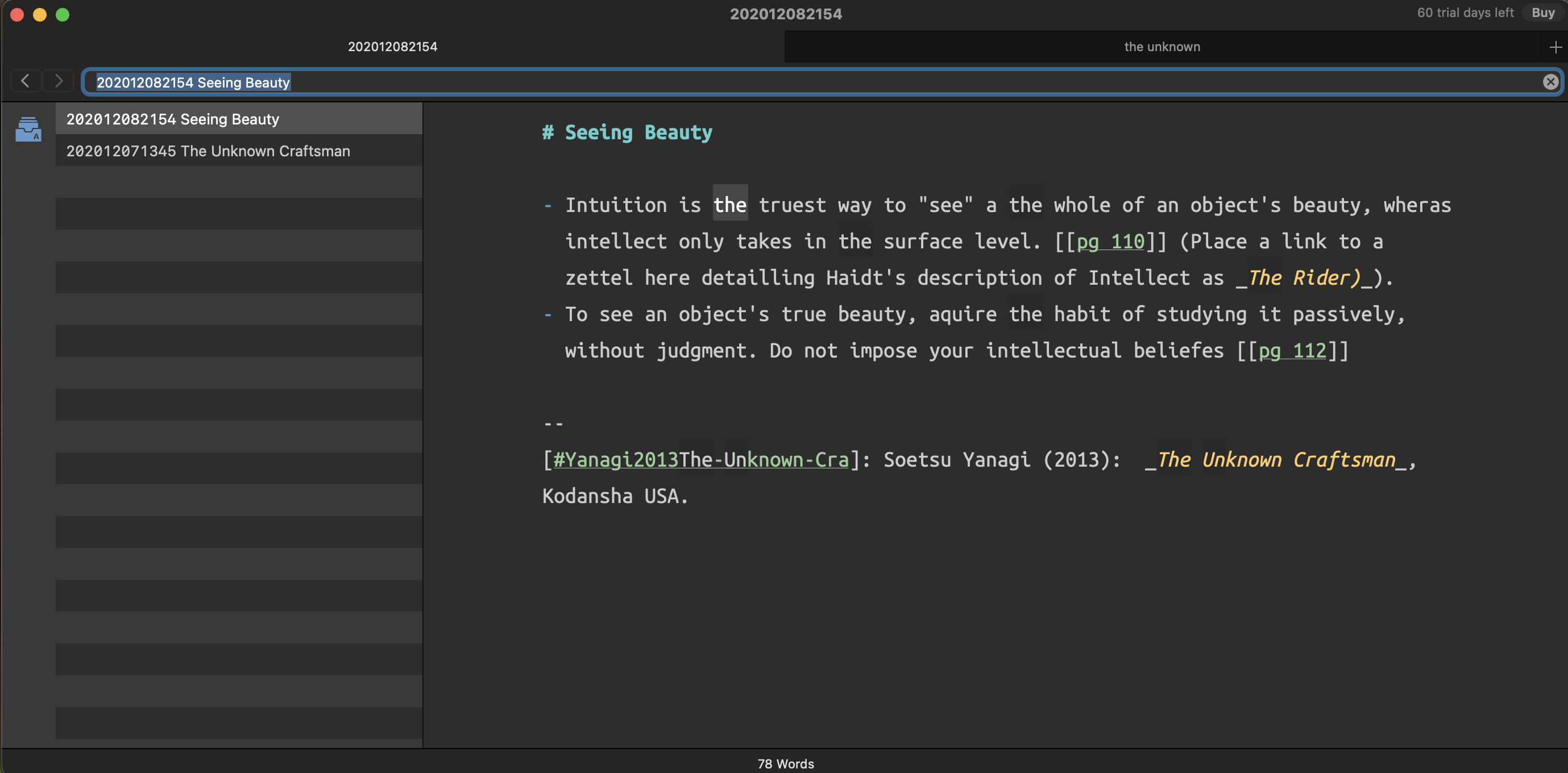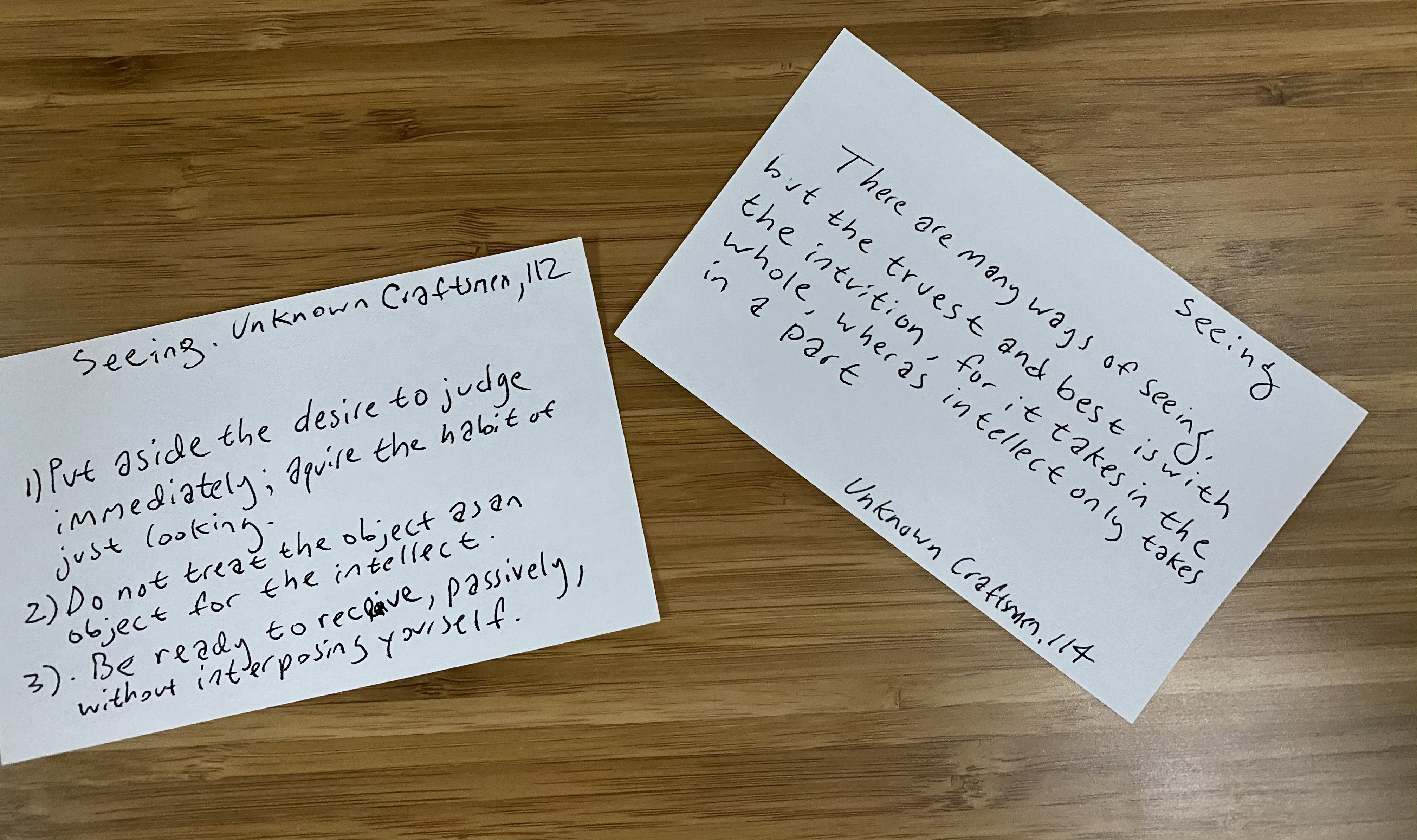Should Zettels be individual ideas or lists of ideas? When to use both?
As I process the notes from a recent book I read as Zettels into The Archive for the first time, I have a question about structure: Should each Zettel contain one idea, that is then nested into structures within structures?
Such as: Idea/note ---> theme---> book Theme TOC?
To ask another way, should the listed ideas here be individual zettels, with Seeing Beauty acting as a thematic TOC for the book?
Notes from when I read the book...
Thanks for the advice!
Charles
Howdy, Stranger!
Comments
@WoodruffCoates, I have two kinds of notes in my archive. Notes that attempt to be atomic in the sense that this contains a whole discrete idea. I'd have to say that only sometimes am I successful at this. The second type of note is a structure note. A note that adds some structure to a group of notes.
In your case, I'd start with a structure note to hang all my notes from the book on. Early on in my zettelkasten journey, I just made a TOC and grouped the notes by chapter. This was easy, but now it feels boring, and I'm going back and refactoring some of these.
I'm evolving towards a system called 'Idea Index' which is more of an "Annotated Table Of Ideas."
There are far fewer structure notes and mostly individual atomic notes in my archive, but structure notes do a lot of work for me. I can quickly review a book, or in the case of the Idea Index, I can review a particular idea from a particular author. They motivate me and help me see gaps in my understanding. They provide a place to originate a note/idea from.
My methods are not a great model in every use case.
Here is a sample of a structure note I made a few months ago.
"Place" was one of the book's themes, and these notes are from different parts of the book. I put them together because they were about the same idea, "Place."
Gary Snyder (2004): The practice of the wild: essays, Washington, DC: Shoemaker \& Hoard,
Will Simpson
My peak cognition is behind me. One day soon, I will read my last book, write my last note, eat my last meal, and kiss my sweetie for the last time.
My Internet Home — My Now Page
I think I made a mistake by presenting structure notes mostly in the TOC-style. There are many ways to tackle the issue of thinking about relationships between notes and create a note on this relationships. These two core paradigms of structure notes might help you:
@Will got it right intuitively by rejecting the strict TOC as the only way to go.
Here is a sample structure note which is a table:
When you got that down most of the issues you are presenting will solve themselves organically.
I am a Zettler
Hi @Will,
Thanks for mentioning the idea index! Clustering zettels by theme makes sense to me, since I find many overlapping ideas in the books I read.
In The Righteous Mind: Why Good People Are Divided by Politics and Religion , Johnathan Haidt speaks about Intuition and Intellect in the same say that Yanagi does in The Unknown Craftsman.
As I process the ideas from Yanagi’s and Haidt’s books into Zettels I know that somehow the Zettels will connect. They could connect through a structure note based on an overarching theme of Intuition vs Intellect , or directly to each other.
As always, thanks for your input!
I’ll share my insights once my ZettelKasten begins to takes shape.
@Sascha Thank you for boiling the process of structuring zettels down to the goal/purpose in mind. Why am I doing this? Is an important question to keep asking, as it serves as a compass!
A structure note is a "control panel" for ideas. I love this and should get it tattooed on my forehead. They are not just 'lists.' They are one of the key places to think in. They let you see where your gaps in understanding are and where your research should head.
I'm a slow learner, and now I'm revisiting old TOC's and refactoring the structure adding more detail, and trying to express the ideas. @Sascha, thanks for all your examples and help .
Will Simpson
My peak cognition is behind me. One day soon, I will read my last book, write my last note, eat my last meal, and kiss my sweetie for the last time.
My Internet Home — My Now Page
I'd suggest two separate structure notes, one for each book. Liberally link the two through the atomic notes where applicable. My logic for suggesting this is that the future is a big place and who knows which of these structures will lead to something else or not. I like to think of a book, class, video, podcast, and a molecule that contains atoms. In my analogy, two books in one structure note would be a chimera (not in the good sense).
The Idea Index metaphor would be used on individual books, etc. An author presents ideas in a book, then you extract them and make arguments, contradictions, affirmations, questioning them as you create atomic zettel. Once at the atomic level, then the connection to other atomic level zettel could be created.
Below is an image of part of an Idea Index. In it, you can see individual atomic zettel and the"idea" it is structured under. Notice
# Technique Of Haiku [[202002241046]]is both an idea category and an atomic link. In your example, I might suggest an idea category# The Righteous Mind/The Unknown Craftsman [[202012090812]]. This would link to your ideas about the intersection of these two books. You should adapt this if there is more than one intersection wanting attention.Will Simpson
My peak cognition is behind me. One day soon, I will read my last book, write my last note, eat my last meal, and kiss my sweetie for the last time.
My Internet Home — My Now Page
Zettels are individual ideas but I'll usually create a list of Related ideas at the bottom of any given zettel. So both? Here is an example from my zettelkasten
On the right is an individual zettel. I have the notes content than at the bottom I link to related concepts. On the left is a bibliography note from the book I'm currently reading. As you see it is an idea index embedded in the table of contents of the book.
To try to better answer your use case. What I would do is keep multiple ideas together. When you find yourself wanting to reference a specific part and expand upon it, say the second bullet point you have, then I'd spin it off into its own note and link to it in the former note.
@Nick would you be so kind to share your Roam theme? I would like to have a look at it as well.
Many thanks!
@Sascha: Thanks for your important post! I'm still writing on the article about different kinds of notes in a zettelkasten that I announced two weeks ago – part of it was going to critique the "narrow" view of structure notes as annotated TOCs. I will rewrite that section now since we seem to have a more similar view than I thought. The blog posts about and typical examples of structure notes that I've seen on this website so far are indeed a bit misleading then.
@Sascha : Thank you for bringing this up again. When you first posted about this a few months ago (https://forum.zettelkasten.de/discussion/comment/7632/#Comment_7632) it radically changed my narrow thinking of what structure notes can be used for. (Also H.T. to @will who helped me understanding the importance of every note beginning from a structure note.) It helped me on a recent article that I was processing of an author's proposal regarding the chiastic literary structure in a portion of the Bible.
I wanted to ask about the other types of structure notes that you mention here and their usages when combined, but I didn't want to steal the thunder from your upcoming book. But since the topic has been brought up in a different context, would you mind sharing an example of flow and scheme structure notes? The others you list seem somewhat self-explanatory (and I believe you've touched on others before as well), but I'm curious about those two types.
@Darryl I don't mind. But I will create a blogpost to cover this topic, so it will not burried in the forums.
I am a Zettler
Thanks @Sascha looking forward to the upcoming post!